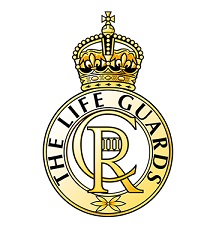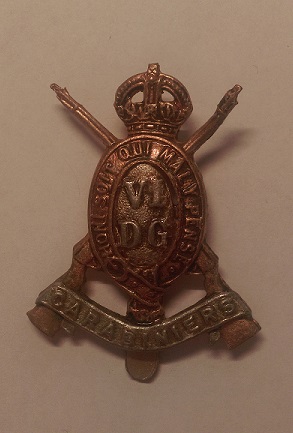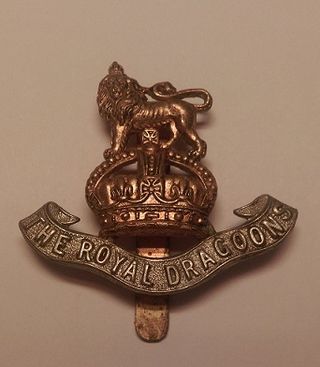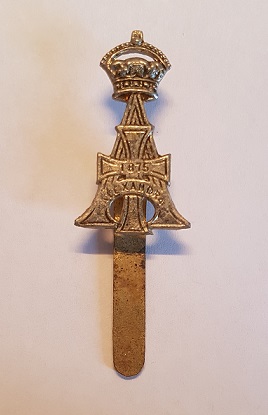
William Philip Sidney, 1st Viscount De L'Isle, known as Lord De L'Isle and Dudley between 1945 and 1956, was a British Army officer, politician and Victoria Cross recipient who served as the 15th governor-general of Australia, in office from 1961 to 1965. He was the last non-Australian to hold the position.

The Royal Regiment of Horse Guards, also known as the Blues, or abbreviated as RHG, was one of the Cavalry regiments of the British Army, and part of the Household Cavalry. In 1969, it was amalgamated with the 1st The Royal Dragoons to form the Blues and Royals.

Charles Hardinge, 1st Baron Hardinge of Penshurst, was a British diplomat and statesman who served as Viceroy and Governor-General of India from 1910 to 1916.

Prince William Augustus Edward of Saxe-Weimar-Eisenach,, PC(Ire) was a British military officer of German descent. After a career in the Grenadier Guards, he became Major General commanding the Brigade of Guards and General Officer Commanding the Home District in 1870, General Officer Commanding Southern District in October 1878 and Commander-in-Chief, Ireland in October 1885. He was promoted to field marshal in 1897 despite his career including no great military achievements.

TheLife Guards (LG) is the most senior regiment of the British Army and part of the Household Cavalry, along with The Blues and Royals.

The 5th Royal Irish Lancers was a cavalry regiment of the British Army. It saw service for three centuries, including the First World War. It amalgamated with the 16th The Queen's Lancers to become the 16th/5th Lancers in 1922.

The Major-General commanding the Household Division commands the Household Division of the British Army and is also the General Officer Commanding London District. In British Army parlance, "The Major-General" always refers to the Major-General commanding the Household Division. The Major-General has sole responsibility for the Service aspect of all State and ceremonial occasions within London District. The office holds executive command of the Household Division and of any other units brought into London for providing military security to the Sovereign, the Royal Palaces as well as for ceremonial purposes and is the main channel of communication between the Household Division and the Monarch. He or she is appointed by The Sovereign, and will previously have commanded a Regiment or Battalion within the Household Division.

The Carabiniers (6th Dragoon Guards) was a cavalry regiment of the British Army. It was formed in 1685 as the Lord Lumley's Regiment of Horse. It was renamed as His Majesty's 1st Regiment of Carabiniers in 1740, the 3rd Regiment of Horse (Carabiniers) in 1756 and the 6th Regiment of Dragoon Guards in 1788. After two centuries of service, including the First World War, the regiment was amalgamated with the 3rd Dragoon Guards (Prince of Wales's) to form the 3rd/6th Dragoon Guards in 1922.

Frederick Edward Grey Ponsonby, 1st Baron Sysonby, was a British soldier and courtier.

The 10th Royal Hussars (Prince of Wales's Own) was a cavalry regiment of the British Army raised in 1715. It saw service for three centuries including the First World War and Second World War but then amalgamated with the 11th Hussars (Prince Albert's Own) to form the Royal Hussars (Prince of Wales's Own) in October 1969.

The 1st King's Dragoon Guards was a armoured cavalry and dragoon guard regiment in the British Army. The regiment was raised by Sir John Lanier in 1685 as the 2nd Queen's Regiment of Horse, named in honour of Queen Mary, consort of King James II. It was renamed the 2nd King's Own Regiment of Horse in 1714 in honour of George I. The regiment attained the title 1st King's Dragoon Guards in 1751. The regiment served as horse cavalry until 1937 when it was mechanised with light tanks. The regiment became part of the Royal Armoured Corps in 1939. After service in the First World War and the Second World War, the regiment amalgamated with the 2nd Dragoon Guards in 1959 to form the 1st The Queen's Dragoon Guards.

The 4th Royal Irish Dragoon Guards was a cavalry regiment in the British Army, first raised in 1685 as the Earl of Arran's Regiment of Cuirassiers. It was renamed as the 4th Dragoon Guards in 1788 and service for two centuries, including the First World War, before being amalgamated with 7th Dragoon Guards, to form the 4th/7th Dragoon Guards in 1922.

The Royal Dragoons was a heavy cavalry regiment of the British Army. The regiment was formed in 1661 as the Tangier Horse. It served for three centuries and was in action during the First and the Second World Wars. It was amalgamated with the Royal Horse Guards to form The Blues and Royals in 1969.

The 2nd Regiment of Life Guards was a cavalry regiment in the British Army, part of the Household Cavalry. It was formed in 1788 by the union of the 2nd Troop of Horse Guards and 2nd Troop of Horse Grenadier Guards. In 1922, it was amalgamated with the 1st Life Guards to form The Life Guards.

The 19th Royal Hussars (Queen Alexandra's Own) was a cavalry regiment of the British Army, created in 1858. After serving in the First World War, it was amalgamated with the 15th The King's Hussars to form the 15th/19th The King's Royal Hussars in 1922.

The 12th Royal Lancers was a cavalry regiment of the British Army first formed in 1715. It saw service for three centuries, including the First World War and the Second World War. The regiment survived the immediate post-war reduction in forces, but was slated for reduction in the 1957 Defence White Paper, and was amalgamated with the 9th Queen's Royal Lancers to form the 9th/12th Royal Lancers in 1960.

The 15th The King's Hussars was a cavalry regiment in the British Army. First raised in 1759, it saw service over two centuries, including the First World War, before being amalgamated with the 19th Royal Hussars into the 15th/19th The King's Royal Hussars in 1922.

The Horse Grenadier Guards, usually referred to as Horse Grenadiers, were a series of cavalry troops in the British Household Cavalry between 1687 and 1788, who used grenades and other explosives in battle. Originally attached to the Horse Guards, they became independent for a century before being disbanded. However, the men of the troops formed the basis of the new troops of Life Guards.
The Royal Households of the United Kingdom consists of royal officials and the supporting staff of the British Royal Family, as well as the Royal Household which supports the Sovereign. Each member of the Royal Family who undertakes public duties has his own separate Household.


















